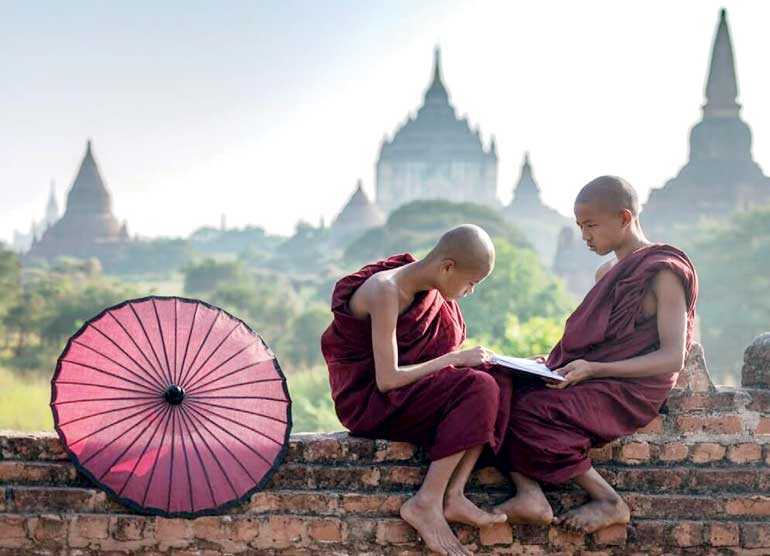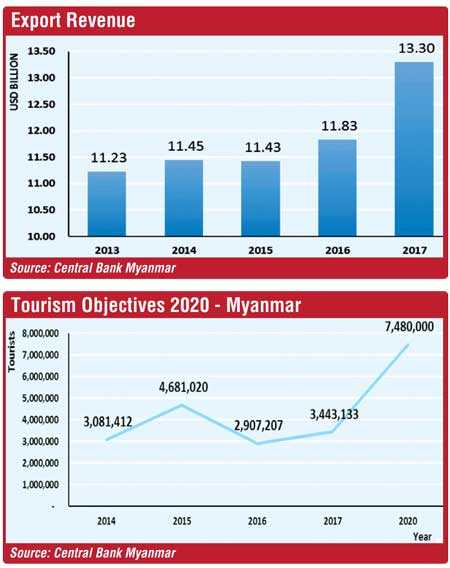Wednesday Apr 16, 2025
Wednesday Apr 16, 2025
Thursday, 12 July 2018 00:00 - - {{hitsCtrl.values.hits}}

We have heard that the great Lee Kwan Yu wanted Singapore to be like Sri Lanka way back in the sixties. Today, Singapore is a $ 349 billion economy whilst we are at just a quarter of that value at around $ 85 billion.
Then we consider ourselves to be better than Bangladesh. Once again, way back in 1990, Sri Lanka, Bangladesh and Vietnam were at just $ 2 billion in export revenue. Today, Bangladesh is at $ 37 billion and Vietnam is at $ 213 billion whilst Sri Lanka is at just $ 11.5 billion.
Now we see that Myanmar - a country which was in the closet until 2010 due to the issue of ethnic cleansing – has touched 6.7% GDP growth in 2017, with tourist arrivals crossing 3.4 million and exports passing the $ 13 billion mark, beating Sri Lanka on all fronts. Many are asking if this is the performance we expected from the progressive government that we voted in in January 2015.
Myanmar 
I guess the world has moved fast whilst we in Sri Lanka are worried about who will be the next president rather than asking ourselves how we can be more competitive. Let me now peg ourselves with a country like Myanmar and see where Sri Lanka stands.
Better known globally as Burma, the country has a population of 54 million. The size of its economy is smaller than Sri Lanka’s at just $ 65 billion whilst its largest city is Yangon (called Rangoon).
Tourism
While Sri Lanka attracted around two million visitors to the country in 2017, Myanmar welcomed 3.4 million tourists into the country with revenue touching $ 2.5 billion. The current customer mix comes in from countries such as the Philippines, Vietnam, Thailand, Singapore and China. The country is targeting the next wave of growth to come from Europe, with an aggressive marketing plan sketched to achieve 7.4 million visitors and $ 10 billion. The country has floated a global tender for a marketing and communication campaign, with the top seven advertising agencies globally bidding for business.
What is noteworthy is that Myanmar Tourism Marketing (MTM) is very strong with their digital marketing strategy. The communication mix includes Facebook, Twitter, YouTube and Instagram. Apart from the digital pull strategy, MTM is using a push strategy with a strong linkage to western wholesales like travel agents and Destination Marketing Companies (DMCs). On the profile strategy, Myanmar has picked the key bloggers that reach key markets and has aggressively pushed the agenda on the brand value side. As at 2017, the brand has been pegged at $ 55 billion, growing at almost 30%.
Sri Lanka on the other hand has been trying to launch a global marketing campaign since 2015, whilst the one call from the private sector had been to drive a global positioning for the brand given the increased supply of room stock.
On brand value, the country has grown at single digits to around $ 73 billion given the drag on its reputation due to the Central Bank scam which is the first of its kind globally. As we speak, the two signatories on a typical Sri Lankan currency note have had notices issued against them by Interpol whilst the other ‘resigned’ due to fraud allegations that have been backed by facts from the Attorney General’s Department.
Exports
Myanmar beat Sri Lanka›s export number of $ 11 billion way back in 2013. Today the country is crossing $ 13 billion in export revenue as at end 2017, while Sri Lanka is still at $ 11.5 billion, which shows us the internal drive it has on this sector.
The key to Myanmar’s aggressiveness in the arena of world trade is the strong policy reforms the country takes with the private sector. In a bid to contain the country’s trade deficit, the Ministry of Commerce (MOC) launched a National Export Strategy targeting a new list of products. Strategically identified by the ministry and the private sector based on market demand, products such as fruits, handicrafts, gems and jewellery, processed food products and IT services were added to an existing list of seven other promoted sectors such as rice, beans, pulses and oilseeds, fisheries, forestry products, textiles and garments. 
The uniqueness of the country is how they use the most modern techniques to build the economy. Studies are currently being conducted on the feasibility and benefits of promoting the new products for new export markets based on the theory of ‹comparative advantages of a nation›. This move comes with the strategic thinking coming from the WTO and World Bank. The Myanmar Investment Commission had invited proposals from the machinery sector of the country which includes automobiles and auto parts, tractors and trailers, telephones and telecom equipment, machines, power distribution and installation, iron and steel construction materials which explains the policy reforms that are currently being actioned.
Dr. Vilem Semerak, lecturer at the Institute of Economic Studies of Charles University in the Czech Republic, whose research focuses on economic reforms and trade in Myanmar, who consults with the Myanmar Export Development Board, says that import substitution, while being positive for the economy in the short term, should ultimately lead to the industrialisation of the sectors involved.
He goes on to state that industrialisation will help Myanmar develop and expand its export market as well as help it leverage its comparative advantages in production, which adds more value over the long term compared to simply replacing imported products with locally-made goods.
The country is targeting $ 20 billion by 2020, which incidentally is the same target set by Sri Lanka. However, on strategy, we see a gap in the two countries on policy, implementation and growth momentum.
What next for Myanmar?
Whilst the country is driving the global agenda strongly, just like Sri Lanka it has its own issues. The UN is branding the Rohingya crisis a case study in modern times of a country which has perpetrated ethnic cleansing.
The Rohingya crisis has put the country in the spotlight with some even stating that tourists must boycott the country. When the Canadian Ambassador to Malaysia tweeted, “First day of 2018 unfolds on Myanmar beach where the great surf is perfect for snorkelling to see nature and fish,” there was a global cry and ultimately he was officially asked to delete his tweet. The point we need to understand is that Myanmar is making strong policy reforms against the backdrop of the world pinning its back against the wall.
Conclusion
For Sri Lanka, the times when the world was anti-Sri Lankan are behind us. We have connected with the world post-2015. The world is positive towards us, with us regaining GSP+ being one of the few indicators of this. But sadly we are losing the game on many fronts to countries like Myanmar due to issues of competency such as governing the country, getting work done by the public sector on policy reforms and earning the credibility of the private sector on the government’s growth agenda.
(The writer was the Executive Director of the National Council for Economic Development (NCED), when the country was touching 7% GDP growth and he is the first person to shoulder the responsibilities of being the Chairman of the Sri Lanka Export Development Board and Sri Lanka Tourism Promotions Bureau. He currently heads a global multinational for South Asia.)
Discover Kapruka, the leading online shopping platform in Sri Lanka, where you can conveniently send Gifts and Flowers to your loved ones for any event including Valentine ’s Day. Explore a wide range of popular Shopping Categories on Kapruka, including Toys, Groceries, Electronics, Birthday Cakes, Fruits, Chocolates, Flower Bouquets, Clothing, Watches, Lingerie, Gift Sets and Jewellery. Also if you’re interested in selling with Kapruka, Partner Central by Kapruka is the best solution to start with. Moreover, through Kapruka Global Shop, you can also enjoy the convenience of purchasing products from renowned platforms like Amazon and eBay and have them delivered to Sri Lanka.
Discover Kapruka, the leading online shopping platform in Sri Lanka, where you can conveniently send Gifts and Flowers to your loved ones for any event including Valentine ’s Day. Explore a wide range of popular Shopping Categories on Kapruka, including Toys, Groceries, Electronics, Birthday Cakes, Fruits, Chocolates, Flower Bouquets, Clothing, Watches, Lingerie, Gift Sets and Jewellery. Also if you’re interested in selling with Kapruka, Partner Central by Kapruka is the best solution to start with. Moreover, through Kapruka Global Shop, you can also enjoy the convenience of purchasing products from renowned platforms like Amazon and eBay and have them delivered to Sri Lanka.